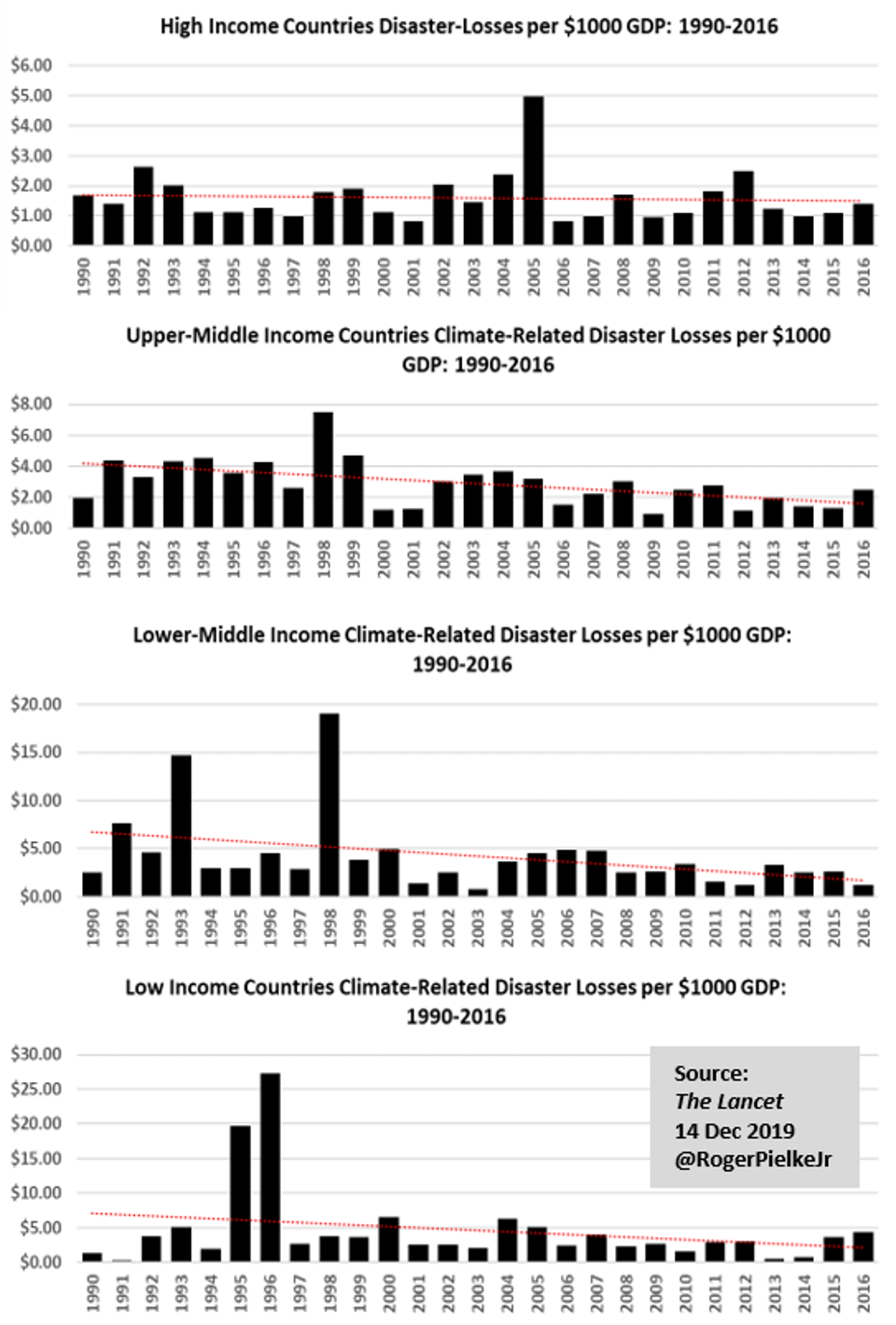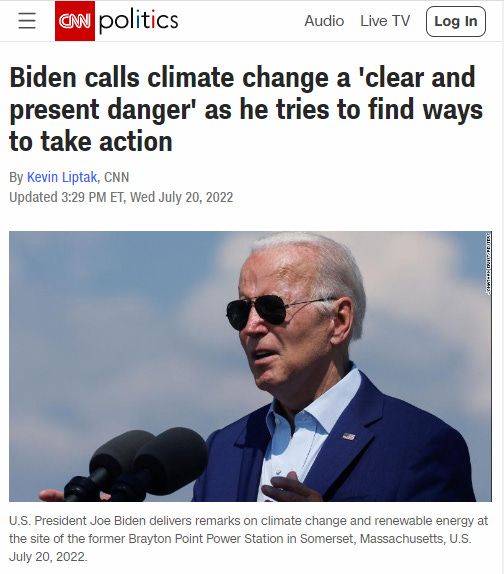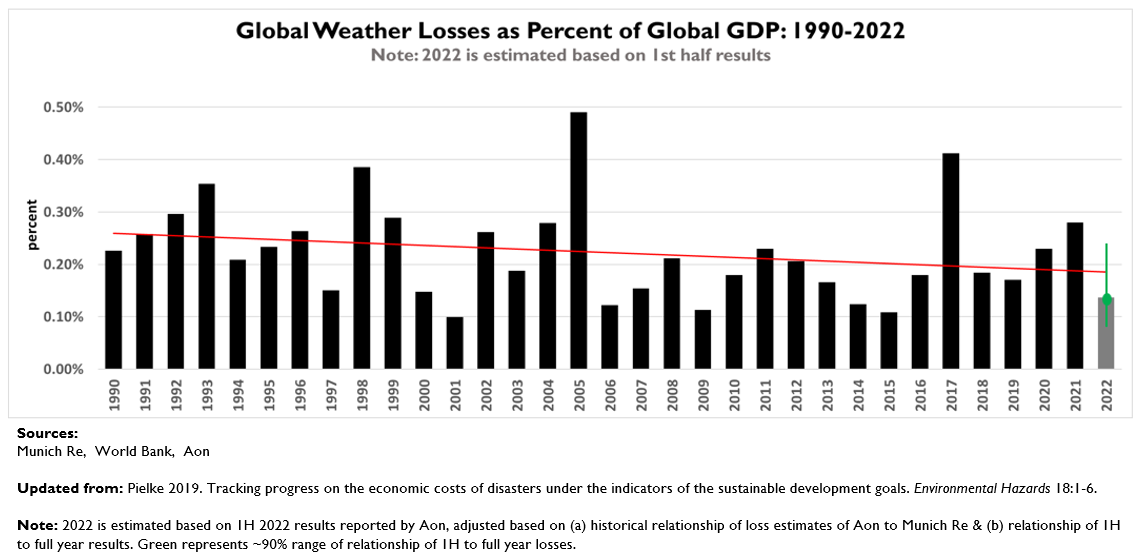Weather and Climate Disaster Losses So Far in 2022, Still Not Getting Worse
An update to global weather and disasters losses 1990 through first half of 2022
It would be easy to think that the economic impacts of weather and climate disasters are just going through the roof. Such thinking is logical because the full cost and impact of every disaster is immediately attributed to climate change, just as the White House did today when referring to the disasters of 2021:
Millions of Americans feel the effects of climate change each year when their roads wash out, power goes down, homes are destroyed by wildfires, or schools get flooded. Last year alone, the United States faced 20 extreme weather and climate related disaster events with losses exceeding $1 billion each – a cumulative price tag of more than $145 billion.
Of course $145 billion is a large number. But it also just about exactly the same number as the $141 billion in disaster losses that the Federal Emergency Management Agency says should have been expected in 2021 — based on historical risk and contemporary exposure. In fact, 2021 was actually a pretty normal year for disasters.
Let’s face it, disasters have become deeply politicized as part of advocacy for climate action. Climate action is important, of course, but not so important that we should mislead people or misrepresent the current state of science. But here we are.
Over many years I have sought to bring some perspective to understandings of the magnitude of the economic costs of disasters by following the metrics of the U.N Sendai Framework for Disaster Risk Reduction. Among those metrics is a recommendation to use disaster losses as a proportion of GDP as a measure of the economic impacts of disasters.
Calculating disaster damage as a proportion of GDP makes sense because as the global economy grows, so too does the amount of property and wealth exposed to potential loss. We should fully expect that over time the economic losses from disasters will grow as wealth grows. So looking just at growing loss numbers may be good for political advocacy, but it doesn’t tell us much about how impacts are changing. (If you want a deeper dive, have a look at my ongoing series on disaster loss normalization, Part 1 here and Part 2 here.)
Twice a year — after the first half of the year and after the year is over — I provide an update to a time series of estimated disaster losses as a proportion of global GDP. The original time series was published in a peer-reviewed paper of mine in 2019, and relies on official data from the insurance industry and the World Bank. The graph below shows the latest update, based on first half (1H) estimates for weather and climate disaster losses in 2022 that were released earlier today.
To estimate full year 2022 losses from 1H estimates from Aon requires two adjustments. One is to adjust the Aon estimates to be in line with those from Munich Re which are the basis for the full dataset (unfortunately Munch Re did not provide a 1H update in 2021 and has not yet done so for 2022). Aon’s estimates are historically about 150% of those from Munich Re, which I discuss in detail here. The second adjustment is to estimate full year losses based on those of the first half. Disaster losses from July through December are typically higher than those from January through June simply because of U.S. hurricanes, which really don’t ramp up until August.
In the figure above a gray bar represents estimated losses for 2022, with the green line spanning a range of losses based on historical relationships of first to second half losses. Lots could still happen in 2022, and thus the full year’s losses might fall outside this range. For instance, a $200 billion U.S. hurricane in 2022 would by itself push 2022 global losses up to 0.35% of GDP, similar to 1993.
What do I recommend that you take from these data?
There is no evidence on a global scale that economic losses from weather and climate disasters are increasing
In fact, since 1990, weather and climate losses as a percentage of GDP have decreased from ~0.25% to 0.20%
That’s good news
In fact, the lack of an increasing global trend in the economic impacts of weather and climate disasters as a proportion of GDP is seen in most places around the world, as shown in the figure below that I produced based on data published in 2019 in The Lancet. Earlier this week I provided a new analysis of disasters in Europe, finding again a decrease in the ratio of disasters losses to GDP.

None of this should be new or surprising, and yet in the highly political discussion of climate, such understandings not only have a hard time breaking through, but are often openly opposed even by those who claim to be respecting science. Climate change is serious and important. And so too is scientific integrity.
Paying subscribers to The Honest Broker receive subscriber-only posts, regular pointers to recommended readings, occasional direct emails with PDFs of my books and paywalled writings and the opportunity to participate in conversations on the site. I am also looking for additional ways to add value to those who see fit to support my work.
There are three subscription models:
1. The annual subscription: $80 annually
2. The standard monthly subscription: $8 monthly - which gives you a bit more flexibility.
3. Founders club: $500 annually, or another amount at your discretion - for those who have the ability or interest to support my work at a higher level.






Psst. https://apnews.com/article/wildfires-storms-science-business-health-7a0fb8c998c1d56759989dda62292379
Problems with the grid and costs to fix them are expected to grow in coming decades, said U.C. Berkeley’s von Meier.
Much of the grid was built decades ago, and the majority of power transmission facilities are now at least 25 years old. That’s forced utilities to quadruple spending on the U.S. transmission system since 2000 to about $40 billion annually, according to Department of Energy data.
Billions more will be spent, with costs passed on to consumers, but those efforts won’t keep up with problems from climate change, von Meier said. “Rates will go up, reliability will go down,” she said.
Roger, simply beautiful work. “Fair, balanced and unafraid.”
This may be your 15 years of fame moment. You deserve it. As Bob Dylan said about Tom waits, he is my secret hero”; And, you are my secret hero, Roger.